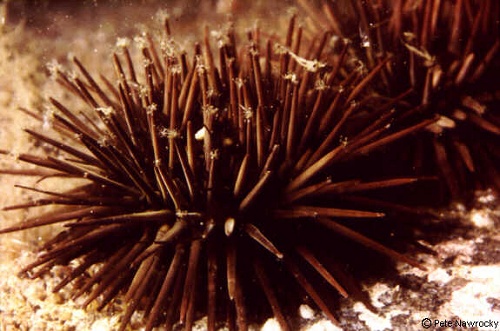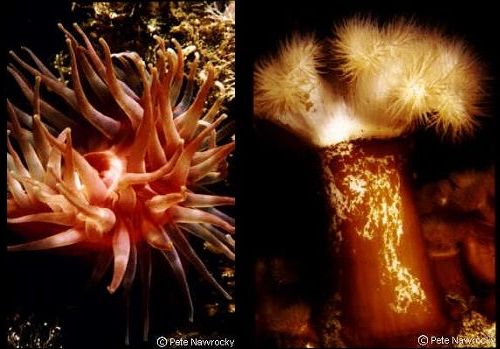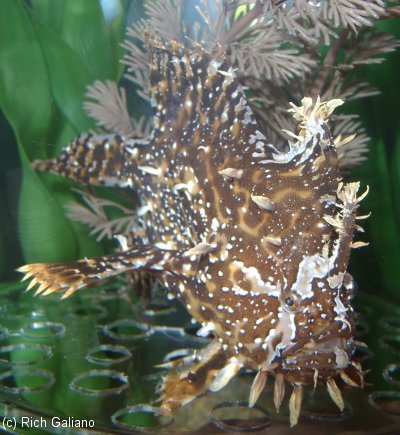Digital Slideshow






Pete Nawrocky is a photographer specializing in the underwater environment of the Northeastern United States. Pete's work has been published in numerous books and magazines, including Skin Diver and Underwater USA, and he is currently a staff writer for the Northeast Dive Journal. Pete has also received the Beneath the Sea Diver of the Year award, and the NAUI Outstanding Contributor to Sport Diving award.

Atlantic Rock Crab - Cancer irroratus
Crabs are carnivorous and typically walk on the sea floor. Their habitat ranges from the deep sea up to shallow water, along the shore, and sometimes well inland. The Atlantic Rock Crab is found on rocky or sandy bottoms at depths from the low-tide line to depths of 2600 feet (780m). Although these crabs were once regarded as pests by lobstermen, as they will enter lobster pots and steal bait, the rise in seafood prices has made the crabs a profitable catch as well.

Northern Sea Robin - Prionotus carolinus
The Northern Sea Robin, which grows to 17 inches in length, inhabits waters off most of the eastern coast of North America, migrating south and offshore during the winter. These fish are bottom-dwellers, feeding on various crustaceans, bivalves, squid, and other fish. Sea Robins can be recognized by the large head, broad mouth, spiny dorsal fin, and wing-like pectoral fins.

Sea Gooseberry - Pleurobrachia pileus
This tiny comb jelly is only about an inch across, but its retractable tentacles can extend over twenty times its body length to snare microscopic food organisms. Comb jellies are noted for their sometimes spectacular luminescence, which is produced by glandular structures near the radial digestive canals. Sea Gooseberries, which unlike most jellyfish do not sting, can be found drifting near shore from Maine to Florida and Texas. Another comb jelly, P. bachei is found from Alaska to Baja California on the Pacific coast, and is indistinguishable from P. pileus outside of the laboratory.

Atlantic Purple Sea Urchin - Arbacia punctulata
This omnivorous species, found on rock or shell bottoms from low-tide line to water 750′ (229m) deep, will eat anything from algae, sponges, and coral polyps, to mussels, sand dollars, even dead or dying urchins or other animals. Sea urchins carry fascinating tiny grooming organs between their spines. These organs, once thought to be parasites, are actually just the opposite: an integral part of the animal which keeps the echinoderm’s surface free from other animal or plant organisms.

Tubularian (Pink Hearted) Hydroid - Tubilaria crocea
This is not a plant, but an animal which attaches itself to nearly any solid object continuously submerged in shallow water. Single pink polyps, each up to 5″ high, combine to form a colony over a foot wide. Individual members of the colony become specialized to perform specific tasks, from eating to defending the colony. This species is found on the east coast from Nova Scotia to Cape Hatteras, and from Washington to California in the west.

Northern Red Anemone and Frilled Anemone
Tealia crassicornis and Metridium senile
The similarities between anemones and their relatives, the corals and the jellyfish, are not hard to see. All spend part, if not all of their lives as polyps anchored to the sea floor or other surface, and most employ stinging cells, or nematocysts, to subdue prey.
Both of these anemones are found in northern waters on the east and west US coasts. The Northern Red Anemone can grow to 5″ high and 3″ wide with a hundred tentacles arranged in rings around the mouth. The Frilled Anemone, which can grow to a height of 18″, may have as many as a thousand slender tentacles which give it the frilled appearance. These anemones can reproduce either sexually or asexually, the latter being accomplished by leaving behind, as they creep over a surface, bits of tissue which regenerate into complete organisms.

Goosefish - Lophius piscatorius
This angler fish is a large bottom-dweller, reaching lengths of up to six feet in depths to 1,800 feet (550m). Lophius are voracious eaters, attracting prey with a modified dorsal fin which acts as a “fishing lure.” They have been known to eat a wide variety of fish, turtles, invertebrates, and even birds. Fishermen comment that the goosefish usually comes up in a trawl with a full belly, having gorged itself on its fellow captives. The appearance of this fish belies the delicately flavored flesh, which is popular in Europe.

Blue Mussels - Mytilus edulis
The edible Blue Mussel is usually found in dense masses attached to rocks, pilings, or nearly any solid object between low- and high-tide lines. These mussels grow to 4″ long and feed on nutrients filtered out of the water which passes into and out of the mantle cavity through the frilled siphons. Breathing also occurs as this stream of water passes over the creature’s gills.

Northern Stony Coral - Astrangia danae
The beautiful reefs of tropical locations are not actually living creatures at all, but are built up of the skeletons left behind by hard or stony corals and encrusting algaes. The Northern Stony Coral is the only shallow-water species of stony coral found north of Cape Hatteras. It is pinkish to white in color, and found attached to rocks or shells in water to 135′ deep.

Black Sea Bass - Centropristes striata
A favorite prize of spearfishing SCUBA divers, the Black Sea Bass is an important food fish throughout the mid-Atlantic states. Growing to 24″ in length, this fish is found from Maine to Florida, usually over rocks and around jetties, pilings, and wrecks.

Ocean Sunfish - Mola mola
Perhaps the strangest in appearance of all local fishes, the Ocean Sunfish with its large dorsal fin is probably responsible for more than a few “shark” sightings at sea. The caudal (tail) fin of the Mola mola is reduced to a short flap, with the dorsal and anal fins used like oars for propulsion. This fish can weigh well over a ton and measure up to 13 feet in length. They are found in both the Atlantic and Pacific oceans, and feed on jellyfishes and other small, soft items.

Sea Star - Asterias forbesi
The Common Sea Star is a familiar sight to any north Atlantic wreck diver. Found on rock, sand, or gravel bottoms from the low-tide line to depths of 160′, this creature can grow to over 10 inches across. This Sea Star feeds mainly on bivalve mollusks, by pulling the valves open just far enough to slip a piece of its stomach inside ( it only needs a tiny space of 1/250″. ) It then secretes digestive juices which begin to consume the mollusk’s soft tissues, and finishes the meal once the bivalve’s shell opens as it dies.

Sea Raven - Hemitripterus americanus
The Sea Raven has the unusual ability to pump itself up like a balloon when removed from the water. If it is thrown back again, it first floats helplessly on the surface, then returns to normal as it lets the air back out again. This fish is often used as bait for lobster, though some claim that it tastes good. The Sea Raven is found along the Atlantic coast of the US, and grows to over two feet in length.

If you are a New Jersey diver, we hope we’ve helped you become better acquainted with the creatures you see on your dives. If you’re not, we hope that we have shown you a little of what New Jersey diving has to offer.
Original NJScuba website by Tracy Baker Wagner 1994-1996
From way back when in 1996

